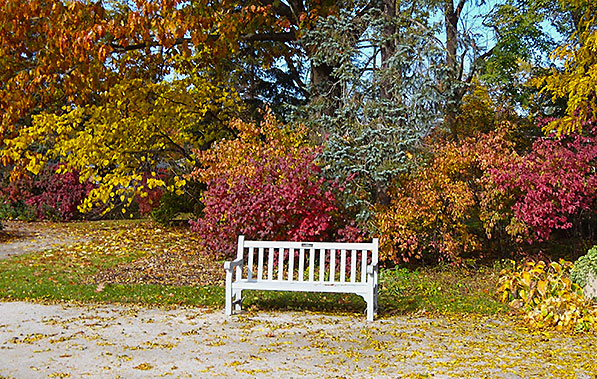The garden staff has been busy this year, planting additional trees and shrubs in the park. Some replace specimens that were damaged, including a very large European Beech. Others were added to newly renovated beds to increase color and texture throughout the year.
We are pleased to offer visitors an updated Park of Roses Tree & Shrub List 2015 so they can enjoy a self guided tour of the woody landscape plants in the Park of Roses. It includes a great diversity of specimens: 62 tree species, of 99 varieties and 19 shrub species of 37 varieties. The list features a map, the botanical and common names of each plant and where you can find it in the park. Trees and shrubs are identified with signs or tags in the garden.
If you are unfamiliar with the binomial (two word) nomenclature of botanical names, here is a brief explanation. Carl Linnaeus was an eighteenth century Swedish naturalist who devised a system for naming plants, animals and minerals based on descriptive Latin words. It is still being used today as the universal language for botanists, plant propagators and serious gardeners to identify very specific plants.
A name consists of at least two words: the genus (first word, Capitalized) and the species (second word, lower case). An additional level of information is provided if there is a third word or set of words- the variety (‘Capitalized’ between single quotation marks).
For instance, all maples belong to the genus Acer. The species tells you which type of maple it is: Acer palmatum. There are 6 different species of maples in the Park of Roses, with a total of 9 named varieties, such as Acer palmatum ‘Crimson Queen’. Translated into English, the name of that particular tree is Japanese Maple ‘Crimson Queen’.
It is well worth the effort to learn this way of identifying plants. Should you admire a tree, rose, herb, annual or perennial flower, knowing the botanical name will help you track it down at the garden center or in a catalog. It will also help in researching details such as height, water and sun needs, and other variables to help the plant thrive in your garden.
A narrated tree walk will be held Thursday, October 22, beginning at 6:00 pm. Led by arborist Jim Slyh, the tour starts outside the volunteer office, at the south end of the enclosed shelter house. No registration is required. Visitors are urged to dress for the weather that day and to wear sturdy walking shoes.
If you are interested in finding out more about the botanical names of plants, several useful books are Latin for Gardeners by Lorraine Harrison, A Gardener’s Handbook of Plant Names, by A. W Smith, and The Pronouncing Dictionary of Plant Names by American Nurseryman Publishing Company. There are many resources online, including this audio pronunciation guide from Fine Gardening magazine.


